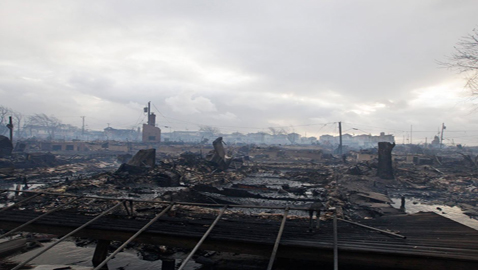Hurricane Sandy’s Macabre Stimulus Package: Billions Earmarked For Clean-Up Operations To Boost Economy
Post Views 1
Analysts are saying that although it will be hard to put a precise figure on the cost, but given its wide range and brutality it was likely to surpass the $46.6 billion in damages caused by Hurricane Katrina 7 years ago. Initial estimates of losses pegged between $30 billion and $ 50 billion may well turn out to be a gross underestimation. It is destined to go on record as the worst-ever in term of economic costs and consequences.
Not only is it going to set new standards in damage costs, it is amongst the largest storms recorded in the Atlantic Ocean, measuring over 900 miles, impacting 10 states, forcing them to declare emergency situations. This quarter’s economic growth for these 10 states is going to show a gaping hole that could take months to fill.
Insurance companies say that they will have to foot a bill of anything between $7 billion and $15 billion. The costs for the insurance companies could have been even higher but for the fact that quite a lot of the destroyed property is uninsured and the companies are also not accountable for public infrastructure like roads and bridges that have borne the brunt of the devastation.
However, the economy hit that the states have taken will be partially equalized and compensated by the cleanup and rebuilding that will continue for months and will increase spending and create new jobs.
Apart from the damage to property, other factors include loss following hampered business activity owing to unopened workplaces, failed transportation and power failures. What added to the woes and costs were the power outages that led to telecommuting businesses not being able to do any work. Tens of millions of people, 8 million in New York area, were without power.
A major portion of the lost business is gone forever and will never be recovered. Others, who had the good sense to be insured may through claim payouts rebuild their business and even make improvements. It is estimated that the insured losses from the storm could reach $8.3 billion.
Mark Vitner, a senior economist at Wells Fargo Securities LLC in Charlotte, North Carolina assessed that eventually the hurricane could take off 0.1 to 0.2 percentage points from the U.S. GDP in the October to December quarter. “There’s a loss of activity that’s going to be hard to make up. If you’re a restaurant and you’re closed today, people are not going to eat two lunches tomorrow.”
The silver lining, however, is that the storm aftermath will see billions of dollars injected into the regional economy. The increased spending will benefit all from people who find jobs, to raw material suppliers, to service providers and construction firms.
John Challenger, CEO of Challenger, Gray & Christmas, an employment firm said, “We will probably see an employment surge in construction, skilled trades and other professions needed to help repair the damage. There will also be an increase in business and consumer spending as companies and homeowners replace damaged equipment, household items, etc.”
Also insurance claim payouts will also see an unanticipated source of money for the regions and this will be a positive development sign for renewed growth for the distressed areas. The cleanup activity will have a constructive impact on GDP growth.
Doug Spiron, who is running an emergency response operation in Atlanta, put the storm in proper perspective saying, “This one has got so many facets to it – you’ve got wind, you’ve got rain, you’ve got snow, you’ve got the full moon, you’ve got the storm surge. Then there’s the impact of the sheer size of the storm. This one takes it to another whole level of preparation.”
Hurricane Sandy’s Macabre Stimulus Package: Billions Earmarked For Clean-Up Operations To Boost Economy by Harrison Barnes


 When to Visit Human Resources
When to Visit Human Resources  Overwhelmed at Work? 7 Simple Strategies to Make Things Better
Overwhelmed at Work? 7 Simple Strategies to Make Things Better  10 Ways to Express Your Company Culture
10 Ways to Express Your Company Culture  Top 4 Most Effective Management Styles & How to Use Them
Top 4 Most Effective Management Styles & How to Use Them  Want to Be a Great Leader? Learn to Listen
Want to Be a Great Leader? Learn to Listen